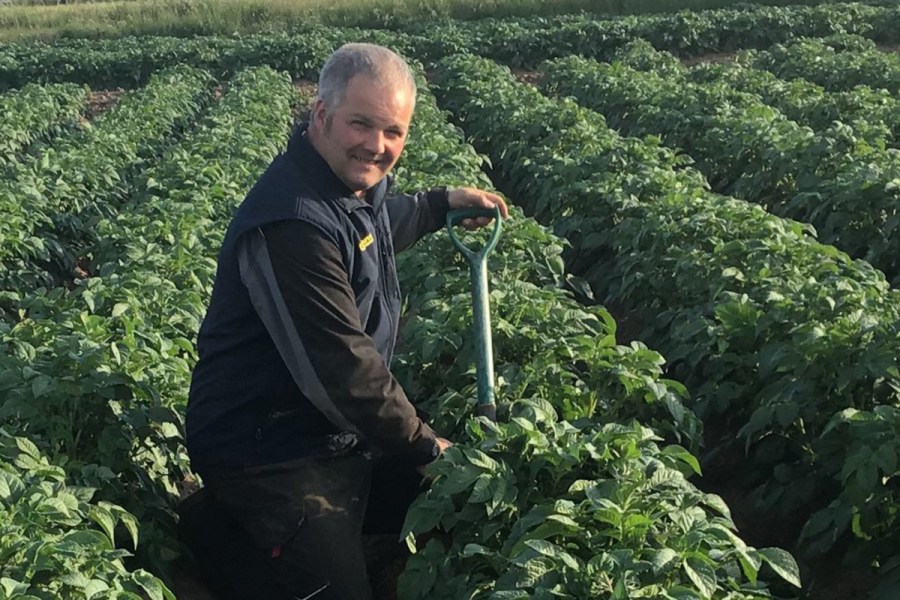By Andrew Wilson
The answer to the question no doubt in most taty growers minds is 2.6% (4acres) That’s what we have left to lift. There are two varieties, in three wet bits, and as things stand at the moment, that’s where they will be staying for a good while yet!
It’s frustrating, but we’ve been here before. It’ll dry up, it always does. Eventually.
My optimism last month for decent yields wasn’t entirely unfounded, and all varieties performed reasonably well. Lifting was more challenging to say the least, and very stop start. We were quite shorthanded this year, for various reasons, but the team stepped up and we got through it.
Storage though, is another matter, and we have moved a chunk of March contracted crop already. We put it in the front of the store because I knew its storability was questionable. Some we washed, some we didn’t, but all 8 loads went into the factory without any bother. I appreciate the flexibility to do this, because the fortunes from potatoes in recent years haven’t put much fat on our back to carry big losses, and it’s in no one’s interest for the crop to run out of the shed. Open, proactive and constructive dialogue with customers is never more important than in times like these.
I believe that where at all possible, ‘give a bit to get a bit’ is the right way forward, and my November contracted tonnage will now stay another month or two, which suits both of us. My few November-contracted crispers have moved bang on time too which is pleasing.
Now the troubled tonnage has moved, and a few cooler nights have allowed pull down to the right side of double figures at least, we have once again treated the rest of that particular store with DMN. The jury is still out on which product to choose for the Jan/Feb store, which presently shows no sign of dormancy break at all. Life was much simpler in the days of CIPC.
So, lessons from the season? (Apart from why we put ourselves through the metaphoric mangle every year?) My approach for most things is as little as possible, but as much as necessary. This is particularly true when it comes to cultivation, where once again the less intensively cultivated fields have taken the weather better. Cover crops here contribute significantly to both reducing the need for bedtilling and improving soil health, but some weren’t very good last year. The spade is still ever essential, and we ‘over egged the pudding’ in one trial by reducing depth too much without sufficient attention paid to compaction. As a result, that area is still to harvest. Last year we converted an old shakaerator to low disturbance legs, and where that was used percolation wasn’t a problem, pretty much to the line. It’s only an acre, but lesson learned.
Our peasant spec row dammer appears to be worth its salt, with noticeably less erosion and water stood in low spots in two particular fields where this has been a problem in the past. This has made the difference between those fields been able to be harvested and not and resulted in a better quality crop to boot. It’s not the most comfortable job to do, so I think a new set of cab mounts and a better seat is called for on the old Nash that we use for the job.
We use a tiny fraction of the nematicides that we used to ten years ago, and soil health checks seem to confirm that beneficial soil life is more intact as a result. The presence and health of worms is always a good guide, along with the texture and smell of the soil. I’m no academic, and as such, tend to experiment on a small scale with alternative ideas rather than seek scientific papers on a subject. This might only be a couple of untreated beds, or a few short beds of an alternative approach, but as a general (mucky handed) rule, if it works consistently and doesn’t cost the earth, keep doing it.
It would be remiss of me not to mention the headache of the moment that is sugar beet. We’re yet to lift any because of the terrible weather, and in a nutshell, I will not be signing any contracts until the proper agreed negotiation process is complete. For British Sugar to think we as growers would roll over and accept an extra fifty pence, and ignore the many small printed caveats is in my view, optimism epitomised. The working time directive and UK weather are not exactly compatible for a start.
The less said about cereal drilling here the better, but some heavy land not planted at the present time has actually saved money, due to the water logging that would of rotted seed off. There will be some field swapping and cropping tweaks to be done in the coming weeks, of that, I am sure.
By the time you read this, the great industry showcase that is BP2023 will have been and gone. I’m quite looking forward to it. Next on the list is the GB Potatoes inaugural AGM, then CUPGRA, so I’ll maybe see some of you at those.
This article was taken from the latest issue of CPM. For more articles like this, subscribe here.
Sign up for Crop Production Magazine’s FREE e-newsletter here.




